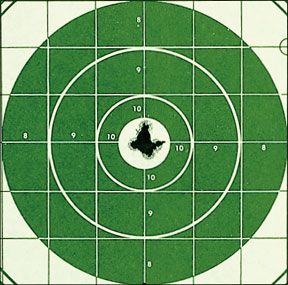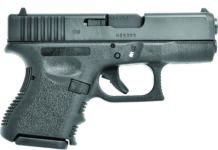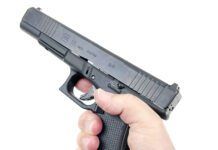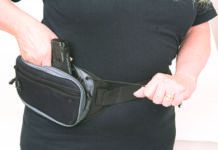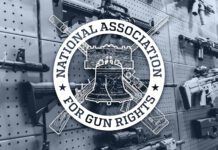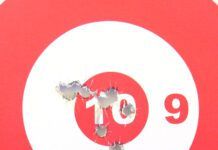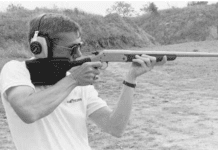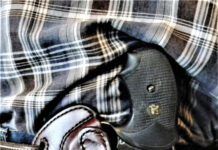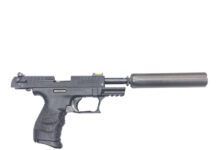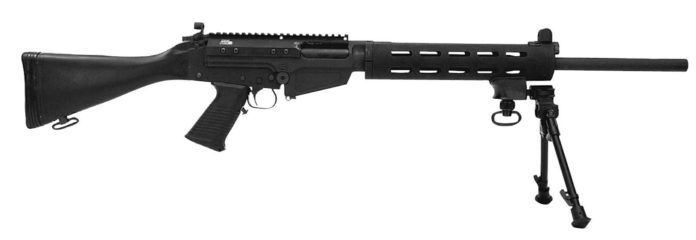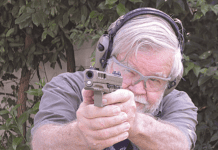Re “308 Semi-Auto Rifles: FNH-USA, Springfield, Fulton, and DSA,” May 2009 I was surprised at the lack of accuracy of the SA58 in your recent test. I’ve had a different experience. The rifle I shot was bought in early 1999 and was/is pretty much the “standard” FAL version: carrying handle, 20-inch standard barrel, sheet-metal barrel guard (not quite standard, but close), typical iron sights, plain old factory 288 trigger. My accuracy results for representative five-shot groups ran 3.25 inches, 2.6 inches, 2.75 inches, and 3.25 inches at 100 yards, using iron sights and Winchester white box ammo. My worst group was better than your best group from the data chart. That’s without a scope, without a fancy trigger, without a fancy barrel, and with white box only. Either DSA quality has hurtled downhill in the last few years, or there was something wrong with your rifle—or possibly I got a really sweet and unusual rifle (that’ll be the day). You can probably guess I’m voting for number two. I’ll also say that you can only test the rifle you have, not the one you don’t; so if you got a lemon, them’s the breaks. I’ll mention that I’ve never felt it was a good idea to put a scope on this rifle as there doesn’t appear to be a really secure method to do so. For me, the SA58 handles very well—it comes up quickly and the rear sight “falls” just in front of my eye. It feels svelte in my hands, not clumsy or fat. No failures to feed or anything else irritating. Negatives are that the magazine rattles in the magazine well, and my thumb can’t reach the stock safety. If you can’t tell already, I really like the SA58 I own. —Edward Sutorik, Sniper Rifle Test Request As you may be aware, Navy Arms is bringing out an M1903A4 sniper rifle replica with a reproduction M73B1 scope under the Gibbs Rifle Co. logo. There are also a number of Mosin replicas with the PU scope available. I would like to suggest that Gun Tests do a comparison of sniper rifle reproductions. A “WWII Sniper Rifle Shoot-out: Gibbs 03A4 vs the Mosin,” would not only be informative and helpful to someone like me who would like to 288 purchase one of these rifles, but would also be of interest historically. How about it? It would have been even more interesting if an I.O. K98k Mauser sniper rifle with a reproduction Zeiss scope could have been included. Initially, I saw an article on the Mauser sniper rifle in Shotgun News, but when I called I.O. and inquired about their availability, the lady who answered the phone said that the rifle was a limited issue two years ago and they were no longer making them. She said that the way the article was written suggested that it was in current production, and they’ve been swamped with calls about it since the Shotgun News story. She told me that right now there are no plans to restart production. I reread the article, and it is written in present tense. It leads you to believe that the rifle is in current production; they even give you I.O.’s phone number to call—very misleading. —Bill Halpin Bill, thanks for the research and the idea. The Gibbs M1903A4 (above) is built using original Remington-made World War II M1903A3 actions and turned-down bolts. Gibbs then utilizes new-made 4-groove barrels made identical to the originals. They also come with original “Redfield” rings and mounts and an exact copy of the M73B1 scope. Like all replicas and historic remakes, the Gibbs M1903A4 has a number of features that intentionally distinguish it from originals. For instance, the barrels are marked with the modern dates of manufacture, and Gibbs also does not remove the receiver markings. I’ve talked to Ray Ordorica about 288 getting this going, so we’ll know something shortly. —Todd Woodard Re “Terrific Trio of Custom 45s: Volkmann, Wilson, Les Baer,” April 2009 I read with great interest about the three custom 45 ACPs. I had written to you a while back asking for such an article, albeit with the inclusion of one other gun. I recently purchased a Springfield TRP (not the TRP Pro) and wondered how it would fare against the likes of the CQB and Les Baer. I regret that you did not include the TRP. Perhaps you can do a follow-up. The TRP is quite a bit less expensive than the three, but I believe it is every bit as good. Not having the skill and resources you have, I cannot be sure. I hope to see such an article in the future. I love your publication. —Tim Salazar I mentioned this to Gene Taylor over the weekend. He’ll see about including the TRP (shown above) in a story he’s working with STI and Para-Ordnance guns. The lineup isn’t quite set yet. —tw Re “Double-Column 45 ACPs: CZ, H&K, and FN Shoot It Out,” April 2009 In your April 2009 test report you gave the CZ 97B a grade of B, with a possible upgrade to B+. The smallest group from 15 yards with the best ammo was 1.3 inches. In an August 2000 test report (“Non-1911 .45 ACPs: Heresy, or Are They Here to Stay?”), you rated the same pistol a Best Buy, and the smallest group from 25 yards with the best ammo was 1.0 inch. Unless you used a Ransom machine rest in 2000 (the article didn’t say so), this discrepancy is too great and requires an explanation. I have owned a CZ 97B since 1999, when it was the latest-and-greatest, and my main problem with it was that it didn’t feed hollow-point ammunition reliably. My gunsmith fixed the problem very quickly with a little bit of ramp polishing, but your April 2009 article didn’t mention any feeding problems. Am I to assume that the latest samples have better-polished ramps out of the box? (In 1999 I was told by CZ USA that the gun was designed and tested only for ball ammunition, since hollow-point ammunition is illegal in the Czech Republic.) 288 As for decocking the CZ 97B, it never entered my mind that it was an issue. I gently lowered the hammer while pulling the trigger—no problem, no special technique required. Was I just lucky? Should I have worried more? —Peter Aczel Roger Eckstine’s team performed both tests. Yes, at right, the CZ 97B’s best group in the April 2009 test was 1.3 inches at 15 yards. The best average group size was 1.7 inches, both shot with his Sierra No. 8815 handload. In the August 2000 issue, the 97B did stand out with the Speer 200-grain hollowpoints, shooting a best group of 1.0 inches and an average group size of 1.3 inches. But the other two ammos from the 2000 test produced results more in line (2.0-inch average group size and a 2.8-inch average group size) with what you would expect if you moved the 2009 handload results to 25 yards. Explanation: Nine years ago, our team’s eyes were better? They got hot and shot better during the CZ string? Who knows? As far as decocking the CZ, we’re super-sensitive about our descriptions of safe handling directions in the magazine.—tw Re “Subcompact 45 ACPs: Glock’s G30SF Makes It Look Easy,” August 2008 Some months ago the Glock 30SF was the subject of your glowing report. In response I purchased a Glock 30SF and had an extended slide installed. Further, I purchased a green Lasermax unit installed it under the barrel, on the rail. It makes for a neat combination. My problem is that I can’t find a holster (right hip) for the gun and have contacted numerous holster makers to no avail! Can you help? —James W. Ogden, The addition of accessories can make fitting a gun to a holster a tricky process. We don’t have a ready answer for your Glock issue, but perhaps someone in the readership has solved a similar problem and can email me a suggestion. You may have to go to a custom unit that can be molded to the gun. —tw AR-15 Barrel Twist Rates I am looking at AR-style rifles and began to compare them against each other and against comparable bolt-action 223 varmint rifles. 288 At various times, I have read where you have tested some of each. One of the immediate things that struck me is the difference in rifling: 1:9-inch for the AR style (1:8-inch for match grade) vs. 1:12-inch for most bolt actions, although some with compact barrels use 1:9-inch. The AR-style varmint rifles I am looking at still use 1:9-inch even if as they reach out to 24″ barrels. What is the best rifling for the 223/5.56mm round and why the difference between these two styles of rifles? Which will be the most accurate, and does that change depending upon whether your primary range is 100, 200 or 500 yards? —Tim St. Onge Generally 1:9-inch twist is a good rate of twist from 40- to 69-grain bullets. A 1:8-inch twist should shoot bullets from 45 to 77 grains well. The 1:7-inch will shoot heavy bullets well, usually 55 grains and up, as long as they will fit in a magazine. The first Colt M16 barrels had rifling twist rates of 1:14 inches to stabilize 55-grain bullets. Later, the Army switched to a slightly faster 1:12-inch twist, and when the 62-grain SS109/M855 bullet was adopted, the twist rate was increased to 1:7 inches. Most factory varmint rifles in 223 Remington have a rifling twist rate of 1:12 inches. This will generally stabilize bullets from 40- to 64-grain weights. Moving up in weight and length, 69-grain bullets prefer 1:10-inch twist, and 1:8-inch twist will stabilize 77- and 80-grain bullets. Above that, 90-grain bullets require a 1:7-inch twist. It is interesting to note that Eugene Stoner wanted a slower twist, allowing the bullet to keyhole, and produce massive tissue damage as it tumbled inside the unfortunate soul on its receiving end. —Gene Taylor Two for One a Good Deal? Greetings! Over 10 years ago, I had a subscription to Gun Tests. Just today, I re-subscribed. So I would appreciate your opinion on following: I am considering trading my S&W 3913 9mm and a Ruger SP101 327 Federal for the new Para PDA 9mm (which cost over $900). Due to budget, I willing to give up two guns to get a top-quality smaller-and-easier-to-conceal 9mm that will stand up to many rounds. Or would you consider the 3913 good enough to just keep? And it is hard to get 327 ammo. Or is there another high-quality 9mm that is easy to conceal that you would recommend? —Jim Bunch We reviewed the Ruger SP101 in the April 2008 issue, and though we recommended both the KSP-3231X and KSP-32731X in 32 H&R Magnum and 327 Federal Magnum, we did note that ammo for both was tough to get. We haven’t reviewed the 3913, which is now offered in LS and TSW versions for $900 and up. However, Roger Eckstine reviewed the similar S&W 4040PD (with titanium frame) in 40 S&W in the June 2004 issue and gave it a Conditional Buy, mainly based on its $812 price tag. We liked it otherwise. So, based on a purely economic evaluation, you’re giving up $1200 in guns to get $900 in the Para-Ord PDA, which we also haven’t tested. Unless you’re unhappy with the 3913 for some reason, we’d stick with it. I’ll try to get both guns tested this year. —tw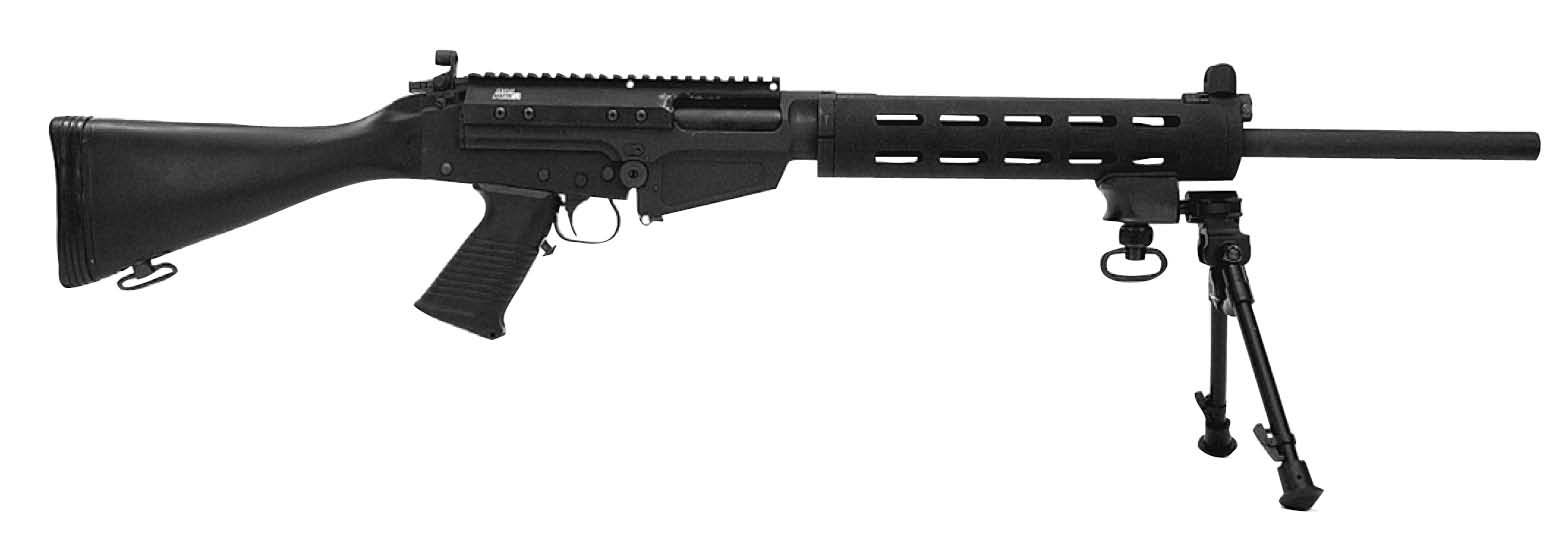
Berkeley, California 
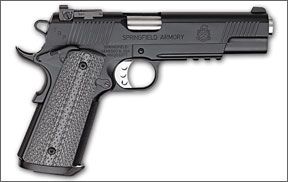
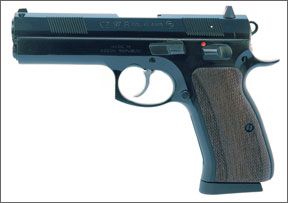
Mansfield, Ohio